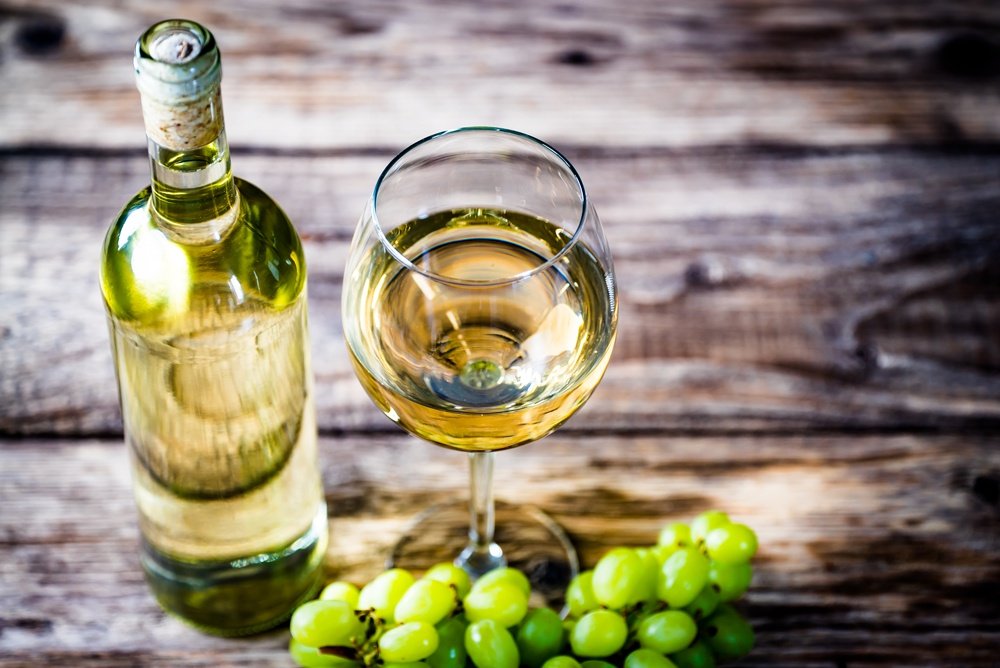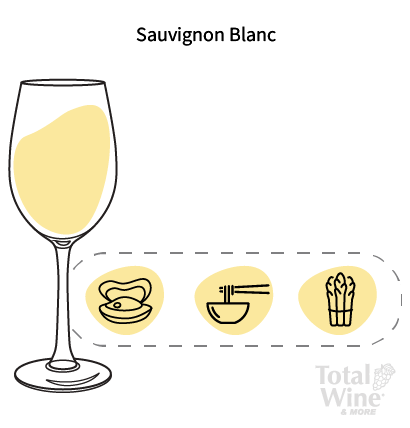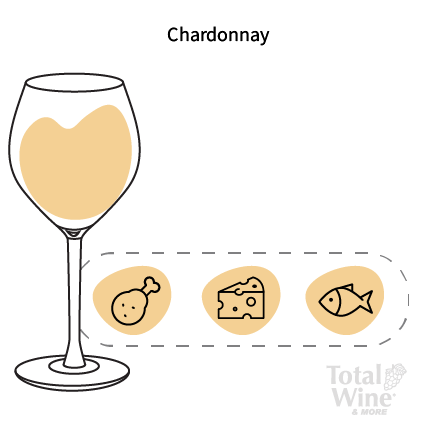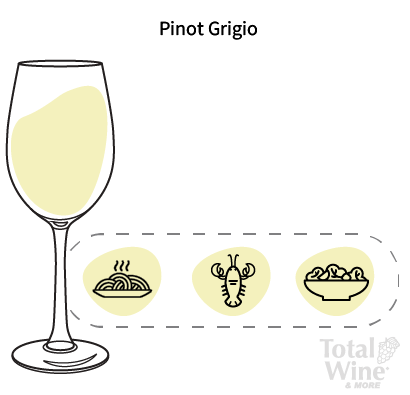Whether you’re looking to pair a wine with dinner or just reaching for a refreshing glass to enjoy with friends, choosing the right one is not always easy. You can’t go wrong with any of these three white wine varieties. Let us help you discover the differences between them and choose the best one for you.
Key differences between Sauv Blanc, Chardonnay, and Pinot Grigio
Sauvignon Blanc, Chardonnay, and Pinot Grigio (or Gris) are all most commonly dry (not sweet) white wines. From there, each wine has its unique flavors and aromas. And as is with most wines, profiles can vary for each varietal depending on where the grapes are grown. Below are some key tasting notes for each of the three wines.
Sauvignon Blanc tasting notes
- Most Sauvignon Blanc wine is dry, light-bodied, and high in acidity.
- Depending on where the grapes are grown, flavors can range from citrus to tropical fruits.
- Many Sauv Blancs have distinctive aromas of fresh-cut grass and green bell pepper
![]()
Chardonnay tasting notes
- Most Chardonnays are dry, with light to medium body, and high acidity.
- Unoaked Chardonnay is fresher and fruitier with flavors of green apple, lemon, and pear.
- Oaked Chardonnay can be more complex with notes of peach, pineapple, and vanilla.
- Winemakers sometimes use malolactic fermentation to add buttery flavors to the wine.
![]()
Pinot Grigio tasting notes
- Pinot Grigio from Italy is light, bright, and high in acid.
- French Pinot Gris can be anywhere from dry to medium-sweet.
- Most Pinot Grigio has flavors of lemon, peach, apple, and sometimes almond and honey.
![]()
Winemaking Regions
Another thing to consider when choosing between Sauvignon Blanc, Chardonnay, and Pinot Grigio is where the grapes are grown. Climate, weather, soil, and other environmental factors have a big impact on the final wine. Let’s explore the primary winemaking regions of each of these wines.

Sauvignon Blanc
As you’ll find with many wines, France is the home to this beloved varietal. In Bordeaux, Sauvignon Blanc can range from dry to sweet and vary in flavors and aromas. If you’re looking for a dry white wine, look for a White Bordeaux Blend. If sweet wines are your thing or you’re wanting to try something new, look for wines labeled Sauternes.
Beyond France, New Zealand is known for fresh and fruity Sauvignon Blanc, as well as the United States, Australia, Chile, South Africa, and more. Learn more about the different wine-growing regions and how they impact the flavors of this wine in our Sauvignon Blanc wine guide.
Our top 3 Sauvignon Blancs to try:
- Montet Sauvignon Blanc
- Mato Bay Reserve Marlborough Sauvignon Blanc
- Carmen Gran Reserva Sauvignon Blanc, 2020
Chardonnay
Chardonnay is a durable grape and can be grown in warm to cool climates. From France to Australia and beyond, it’s hard to find a winemaking region that does not produce Chardonnay.
For centuries, Burgundy, France has been home to some of the most acclaimed Chardonnays. However, you will not find Chardonnay on the bottle, but the appellation instead. Chablis is a well-known appellation that produces crisp, mineral styles.
California is known for a variety of Chardonnay styles. You can find fresh, fruity unoaked versions, as well as wines aged in oak that have flavors of vanilla and smoke. California is also known for buttery Chardonnay, which achieves this flavor from malolactic fermentation.
Learn about the difference between Oaked and Unoaked Chardonnay >
But Chardonnay doesn’t stop there. New Zealand, Australia, Chile, and countless other countries grow Chardonnay grapes to make wonderful wines. Check out our Chardonnay wine guide to learn more about this global wine.
Our top 3 Chardonnays to try:
- Iter Chardonnay California, 2019
- Olema Chardonnay Reserve Sonoma County, 2019
- River Road Chardonnay Unoaked
Pinot Grigio
This white winemaking gape is known by two names — Pinot Grigio and Pinot Gris. However you refer to it, this grape grows well in cool to moderate climates and is most associated with Italy and France.
If you know this grape as Pinot Grigio, you’re probably a fan of the Italian style of wine. In Italy, Pinot Grigio grows in the northeastern regions of Veneto, Trentino-Alto Adige, and Friuli-Venezia Giulia. Wines are usually clean, crisp, and high in acid with flavors of lemon, lime, green apple, and sometimes almond.
In France and other parts of the world, this grape is known as Pinot Gris. Today, most French Pinot Gris comes from the Alsace region where wines can range from dry to sweet.
Learn more about the differences between Pinot Gris and Pinot Grigio >
Pinot Grigio or Gris is also grown in the U.S. in cooler regions of California, as well as Oregon and Washington state. Discover even more about this grape in Pinot Grigio wine guide.
Our top 3 Pinot Grigios to try:
What food pairs with each wine
Chardonnay, Sauv Blanc, and Pinot Grigio are all excellent wines to drink with food. When you are choosing a wine to pair with your favorite dish, try to pick a wine that will not overpower the flavors of the food. Here are some suggestions for each wine.

The high acidity in Sauvignon Blanc makes it one of the most food-friendly wines. Classic pairings include shellfish like oysters, salty cheeses like goat cheese, and Asian cuisines like Thai and Indian. Sauv Blanc is also a great with fresh herbs and green vegetables like asparagus that complement the herbal notes of some styles of the wine.

What to pair with Chardonnay depends on whether you are drinking an oaked or unoaked style. Oaked Chardonnay has toasty, buttery flavors that pair well with smoked dishes like roasted chicken or fattier fish like salmon grilled on a wood plank. Unoaked Chardonnay has more mineral and fruit flavors that go well with lighter dishes like salads and white fish.

When pairing Pinot Grigio with food, it is important to remember to not overpower the flavors of the wine with your food. Opt for lighter dishes like fresh salads, mild cheeses, and seafood. Pinot Grigio also complements Italian cuisine like antipasto, Caprese salads, and tomato-based pasta dishes.
If you are a fan of cheese boards, any of these three white wines will work. From salty, soft cheeses like goat cheese, to sharper cheeses like cheddar, the acidity in Sauvignon Blanc, Chardonnay, and Pinot Grigio will complement the richness of the cheese. Include honey and almonds to enhance the aromas of more complex wines like Oaked Chardonnay and Pinot Gris from Alsace.
So which wine is better? Sauvignon Blanc or Chardonnay? Chardonnay or Pinot Grigio? The choice is up to you! We think all three of these wines are equally enjoyable. Now that you know their flavors, origins, and what foods to pair them with — give them each a try. You may discover a new favorite.
